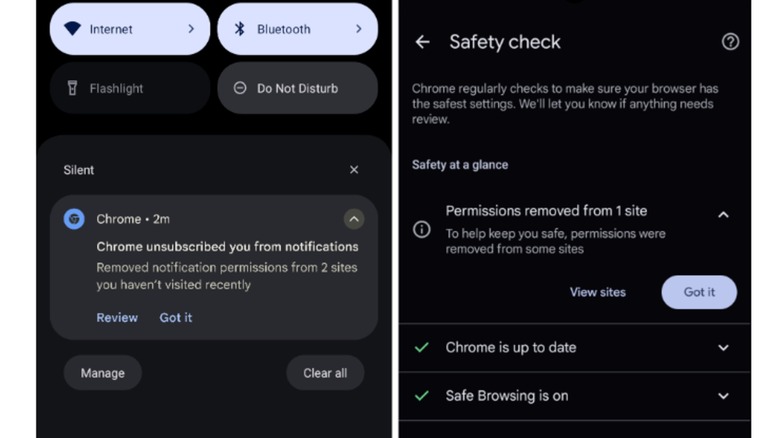Google Is Changing Up Chrome's Notification Permissions For Users - Here's What You Need To Know
If you're the sort of person who habitually clicks "yes" on things, you've likely experienced your important smartphone notifications getting buried beneath an avalanche of unwanted spam from clickbait news sites. Some notifications may even appear dangerous, including false Chrome virus warnings that likely lead to a phishing page or malware. This has been a widespread issue for users, and Google is now addressing the problem head-on.
Notification spam has been a persistent issue for Chrome users. Many websites seek notification permissions (often aggressively), only to abuse that permission by flooding devices with spam notifications. Previously, disabling Chrome push notifications was the only way to cut the problem off at the root. Now, Google is aiming to cut down on those nuisances by changing its approach to site permissions inside of Chrome. In an effort to clean up the browsing experience, the company is cracking down on notification permissions on a site-by-site basis, automatically unsubscribing users from websites they don't engage with. Here's how the new update will change your Chrome experience, hopefully for the better.
Chrome will revoke site permissions to cut down on notification spam
In an October post on the Chromium Blog, Google's Chrome product manager, Archit Agarwal, announced a major change to Chrome's handling of site permissions. Notification permissions granted to a website will remain intact for as long as a user consistently interacts with the site. However, after a period of inactivity, the permission will be revoked. The new approach is similar to how app permissions have worked for several years in Android, and it is being rolled out for Chrome on both Android and desktop (with no mention of iOS).
Google also showed off some new user interface elements, including a notification that informs users when they've been unsubscribed from site notifications. As with Android apps, it appears Google is batching these notifications, which give users the option to acknowledge the revocations or review them manually. Users can also check which websites have had their permissions revoked from a node in Chrome's Safety Check menu.
The company claims that their testing revealed a "significant reduction in notification overload with only a minimal change in total notification clicks" after the change. It also claims that testing showed an uptick in engagement for sites that do not spam users with notifications. There's a distinct lack of hard numbers in that claim, so we'll have to see how the update actually plays out.
Revoking notification permissions is Google's newest front in the battle against spam
Chrome has suffered from out-of-control notification spam for years, and revoking notification permissions appears to be a strategy Google has arrived at after other measures proved fruitless. Users are often spammed with political outrage, sketchy diet supplements, and other such junk. But some notification spam is actively malicious. Notifications claiming a device is compromised by malware are common, and although savvy users can clearly identify them as scams, those with low tech literacy are more vulnerable — especially when notifications appear directly on their phone rather than in the browser.
In May, the Chromium Blog announced that machine learning would be deployed to flag potential spam notifications in Chrome. Using a Gemini-derived machine learning model that runs directly on-device to preserve privacy, notifications are scanned, and the user is notified when spam is suspected. Clearly, those efforts haven't been as successful as the search giant may have hoped. Since the most unique thing about Google Chrome is its dominance over the browser market, these frustrations affect untold millions of users. The move to simply strip notification permissions from any website a user doesn't engage with is a more aggressive measure, but probably an effective one.


